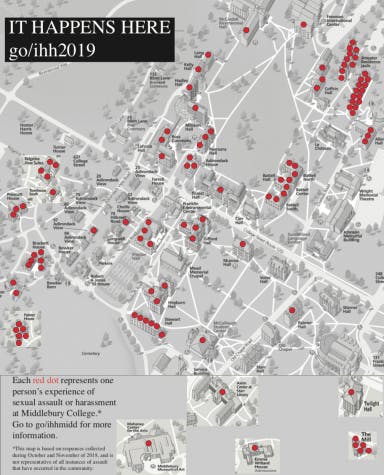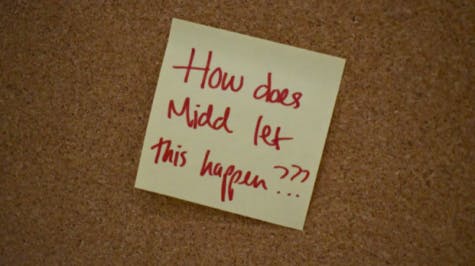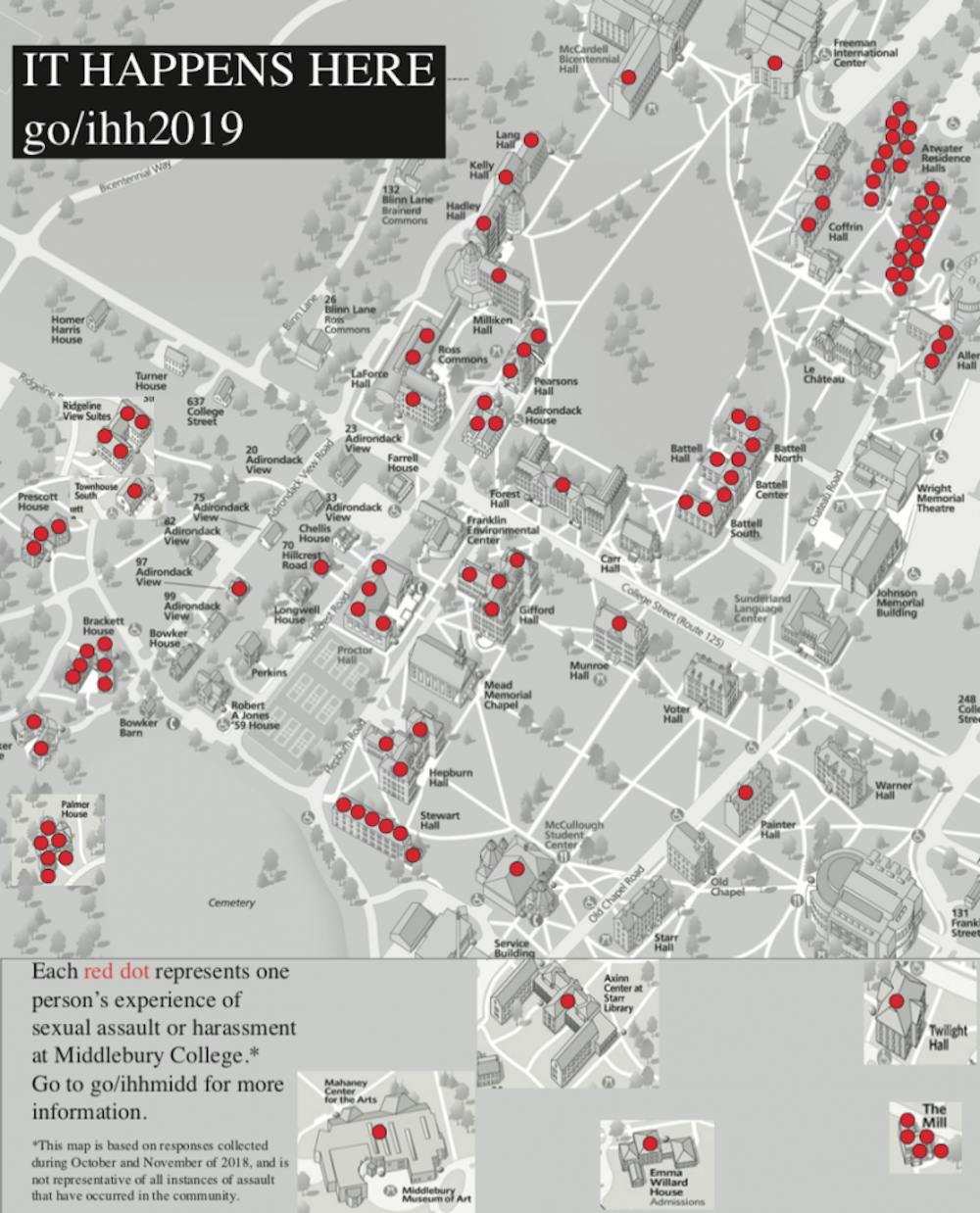Red dots cover the map of Middlebury’s campus. Nine on Battell, four on Proctor and one each on Axinn, Twilight, Munroe and the Admissions Office. Each dot represents one person’s experience of sexual assault or harassment. There are 108 in total.
These instances were put on display in Davis Family Library last week as part of the Map Project, an initiative by It Happens Here (IHH). Students contributed to the map by anonymously submitting instances of sexual assault and harassment via a go-link last fall. Each incident was then demarcated by a red dot on the building in which it happened.
IHH is a group of student activists that raises awareness about sexual assault and works to support survivors in their healing. Its medium of choice is storytelling, and it allows survivors to remain anonymous. In doing so, IHH avoids many of the challenges that typically prevent survivors from coming forward.
This is the second rendition of the Map Project, which was first conducted in 2013.

“The Map is terrifying. It is heartbreaking,” read a description beside the Map.
Observers were invited to share their reactions on sticky notes displayed on an adjacent bulletin board. The reactions expressed sadness and consternation over the prevalence of sexual assault at Middlebury that the map revealed. They included:
“Disgusting.”
“Saddened and sickened that this happens at our college.”
“Looking at this map is really scary.”
“How does Midd let this happen???”
“Rape culture is real.”
“Rape culture is everywhere.”
“I think a lot about the strength the people who work closely with It Happens Here have because looking at this makes me panic but I know it’s important work.”

Students could write and post comments on a board next to the map.
Last Friday, IHH leaders Taite Shomo ’20.5 and Grace Vedock ’20 facilitated a conversation to discuss reactions to the Map, proposed Title IX reforms, how sexual assault is being enabled at Middlebury and what can be done to dismantle campus culture surrounding sexual assault.
To start the discussion, the students and faculty members in attendance introduced themselves and explained why they chose to attend the discussion.
“One of those dots is mine,” Vedock said.
Included in the conversation’s main themes was the air of complacency surrounding sexual assault on campus. Participants said they felt the school’s treatment of sexual assault is often reactionary, rather than proactive.
“The Map Project makes visible and undeniable a problem that is so often brushed aside by the people on campus who can choose not to see it,” Rebecca Wishnie ’20, who attended the discussion, said in a text message to The Campus.
[pullquote speaker="Grace Vedock '20" photo="" align="center" background="on" border="all" shadow="on"]One of those dots is mine.[/pullquote]
Participants emphasized that students must do more to prevent sexual assault than putting Green Dot stickers on their water bottles or attending IHH. They also pointed out that sometimes perpetrators attend IHH, which does not absolve them of their actions.
“This map is a testament to the fact that Middlebury’s Green Dot training and other programs do not address the full scale and range of the problems of rape culture and sexual violence,” Wishnie said. She said that programs like these often center the problem around party culture and substance use.
“This logic perpetuates a culture that blames survivors for entering such spaces and neglects all of the other places and ways that rape culture manifests, rather than recognizing the cultural shift in which we must all participate in order to make this campus safer,” she said.
They also addressed issues with defining sexual assault, rape and consent. Many survivors struggle to determine whether their experiences “count” as assault, and students raised the possibility that some perpetrators may not be aware of what they did.
Some attendees were surprised by the frequency of sexual assaults shown on the map. Others were not.
“When I was putting the map together I was not surprised,” Shomo said. “This in some ways was the worst part.”
[pullquote speaker="Grace Vedock '22" photo="" align="center" background="on" border="all" shadow="on"]In a very un-malicious way, I want people to not be able to unsee the map.[/pullquote]
“For people that have been assaulted it’s not surprising,” Vedock said. “For people that know people that have been assaulted it’s not surprising. But if you don’t fall into either of those groups maybe it is surprising. In a very un-malicious way, I want people to not be able to unsee the map.”
They explained that most of the work being done on campus is by survivors themselves. Survivors are being forced to support themselves and each other with little assistance from the school.
“It’s a huge burden logistically and emotionally no matter who you are, but especially if the issue is personal,” Shomo said. Shomo and Vedock emphasized that it is important for people who are not survivors to get involved.
Their main message: students need to show up and people need to care, even if they have not been personally impacted by sexual assault.
“You should care because people are people, but you should also care because it’s your friends and your family members and your classmates,” Shomo said. Unless everyone commits to dismantling rape culture on campus, Vedock pointed out, the dots will not change.
The Map Project can be found at go/ihh/. This Spring It Happens Here will take place on April 18 at 8:00 p.m. in Wilson Hall.




